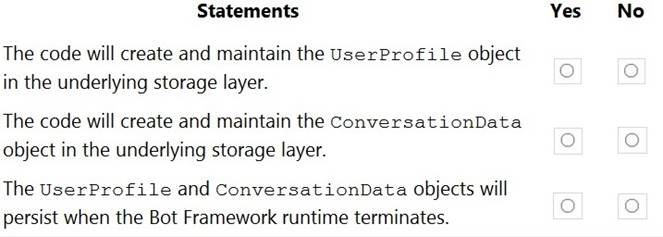HOTSPOT - (Topic 3)
You are building a chatbot by using the Microsoft Bot Framework SDK.
You use an object named UserProfile to store user profile information and an object named ConversationData to store information related to a conversation.
You create the following state accessors to store both objects in state.
var userStateAccessors = _userState.CreateProperty
_conversationState.CreateProperty
For each of the following statements, select Yes if the statement is true. Otherwise, select No.
NOTE: Each correct selection is worth one point.
Solution:
Box 1: Yes
You create property accessors using the CreateProperty method that provides a handle to the BotState object. Each state property accessor allows you to get or set the value of the associated state property.
Box 2: Yes
Box 3: No
Before you exit the turn handler, you use the state management objects' SaveChangesAsync() method to write all state changes back to storage.
Does this meet the goal?
Correct Answer:
A
- (Topic 3)
You are developing a monitoring system that will analyze engine sensor data, such as rotation speed, angle, temperature, and pressure. The system must generate an alert in response to atypical values.
What should you include in the solution?
Correct Answer:
C
- (Topic 3)
You plan to perform predictive maintenance.
You collect IoT sensor data from 100 industrial machines for a year. Each machine has 50 different sensors that generate data at one-minute intervals. In total, you have 5,000 time series datasets.
You need to identify unusual values in each time series to help predict machinery failures. Which Azure Cognitive Services service should you use?
Correct Answer:
A
HOTSPOT - (Topic 3)
You are building a model to detect objects in images.
The performance of the model based on training data is shown in the following exhibit.

Solution:
Does this meet the goal?
Correct Answer:
A
DRAG DROP - (Topic 3)
You Build a bot in JavaScript.
From the Azure Command-Line interface (CLI), you run the following command. az bot prepare-deploy
You need to deploy the bot to Azure.
Which three Azure CLl commands should you run in sequence? To answer, move the appropriate commands from the list of commands to the answer area and arrange them in the client order.
Solution:
To deploy the bot to Azure, you should run the following three Azure CLI commands in sequence:
✑ az deployment group create This command will create the Azure resources for your bot using an ARM template and a parameters file. You need to specify the resource group name, the template file path, and the parameters file path. For example:
az deployment group create --resource-group myResourceGroup --template-file “deploymentTemplatestemplate-with-preexisting-rg.json” --parameters “deploymentTemplatesparameters-for-template-BotApp-with-rg.json”
This command will also output the app ID and password of your bot, which you will need for the next command1.
✑ az webapp deployment source config-zip This command will deploy your bot code
to the app service that you created in the previous step. You need to specify the resource group name, the app service name, and the zip file path of your bot code. For example:
az webapp deployment source config-zip --resource-group myResourceGroup --name myBotAppService --src “code.zip”
This command will also output the URL of your bot endpoint, which you will need for the next command2.
✑ az ad app update This command will update your bot registration with the endpoint
URL of your bot. You need to specify the app ID of your bot and the endpoint URL. For example:
az ad app update --id myBotAppId --set replyUrls=“https://myBotAppService.azurewebsites.net/api/messages”
This command will complete the deployment process and make your bot ready to be tested3.
Does this meet the goal?
Correct Answer:
A